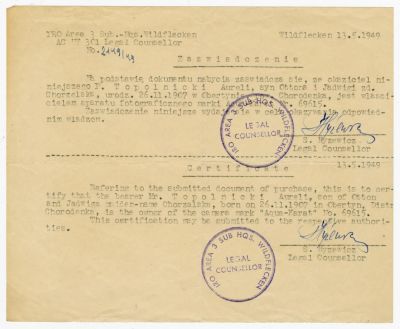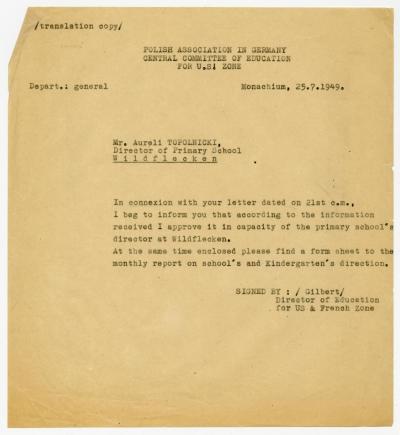The estate of Aureli Topolnicki, resident between 1945 and 1951 in the DP camp in Wildflecken (Durzyn)

The estate of Aureli Topolnicki (1907–1988) comprises 147 documents (including some copies), some of them two or three pages long. Most of them date back to the years between 1944 and 1951, and a few from earlier or later. In addition the estate contains 12 official stamps from institutional facilities in the Wildflecken displaced persons (DP) camp at Durzyn[1]. The documents consist of Topolnicki’s official and private correspondence, passes, identity cards (including membership cards), reports, certificates, testimonials, deeds, application forms, and private notes. A huge number of documents in the estate are original: in addition a large part of them are transcripts, translations – some of these are certified – and copies. Most of them deal with Aureli Topolnicki’s private life (his career, education, studies), his work as a teacher and head of the Polish primary school in Wildflecken or as head of the Wildflecken Polish school district. Furthermore many documents provide information on the context of the emigration of Topolnicki’s family to the USA in 1951. The estate also contains documents belonging to his wife, Irma, and their son, Otto. A specific section of the documents comprises reports on the school and cultural life in the DP camp and general details on the work in schools. The collection of documents is linguistically various: 48 documents are written in the English language, 43 in Polish, 27 in German, two in Latin and one each in Dutch and Chinese. Furthermore many documents are bilingual: the estate contains 18 Polish-English documents, two German-English documents, one Polish-Russian, one English-Latin and one German-Czech document. There are even two trilingual documents: one German-Polish-English and one German-Polish-Russian.
In 2014 Frau Barbara Karbarz brought the complete estate back from the USA to Poland when she returned after the death of her husband, Otto Topolnicki. Whilst she was sifting through his possessions before moving she came across a carefully-sorted collection of documents that had been stored away in an album. It only took a few glances to realise that this material had obviously been highly important to her dead husband’s father for they clearly covered a decisive phase in the family’s life. She asked her brother, the art historian Romuald Nowak from Breslau, to find an institution that might be interested in taking over the estate, using it in a sensible way and storing its contents adequately. Romuald Nowak made enquiries with a large number of institutions (scholarly institutes, museums, archives etc), in Poland, but none of these showed any real interest. Finally he heard of a travelling exhibition entitled “Between Uncertainty and Confidence. The Art, Culture and Everyday Life of Polish Displaced Persons in Germany 1945–1955”,[2] which had been conceived and worked out by the LWL Industrial Museum at the Hannover colliery in cooperation with Porta Polonica. As a result Nowak contacted the head of Porta Polonica, Dr. Jacek Barski, who agreed to take over the estate.
[1] Since most of the people in this huge camp were Poles, the American occupying authorities handed over the administration of the camp – it was more like a town – to them. Subsequently the inhabitants voted to rename the camp Durzyn, and this name was used parallel to its official title.
[2] Osses, Dietmar (ed.): Zwischen Ungewissheit und Zuversicht. Kunst, Kultur und Alltag polnischer Displaced Persons in Deutschland 1945–1955, The book on the exhibition presented by the LWL-Industrial Museum, Essen 2016.









































![Document no. 35/1 Document no. 35/1 - Handwritten letter [in Polish] from M. Paledog from Cheltenham/England to A. Topolnicki.](/sites/default/files/styles/width_100_tiles/public/assets/images/12890-031-1a.jpg?itok=gfPskEix)
![Document no. 35/2 Document no. 35/2 - Handwritten letter from M. Paledog from Cheltenham/England to A. Topolnicki, [p. 2].](/sites/default/files/styles/width_100_tiles/public/assets/images/12890-031-1b.jpg?itok=Df4ctKpD)
![Document no. 36/1 Document no. 36/1 - Envelope to the letter [Document 35] from Paledog to Topolnicki.](/sites/default/files/styles/width_100_tiles/public/assets/images/12890-031-2a.jpg?itok=krd42nL9)
![Document no. 36/2 Document no. 36/2 - Back of the envelope to the letter [Document 35] from Paledog to Topolnicki.](/sites/default/files/styles/width_100_tiles/public/assets/images/12890-031-2b.jpg?itok=K_dTfhNe)

![Document no. 38 Document no. 38 - Topolnicki is informed about the progress of his immigration application [ assurance is recognised].](/sites/default/files/styles/width_100_tiles/public/assets/images/12890-033.jpg?itok=OKjuXvyn)
![Document no. 39 Document no. 39 - [Handwritten copy of the] birth certificate of Irma Saling, the wife of Aureli Topolnicki.](/sites/default/files/styles/width_100_tiles/public/assets/images/12890-034-1.jpg?itok=Qcvw5Oaz)











































































































































![Dokument Nr. 127/1 Dokument Nr. 127/1 - Personalausweis von A. Topolnicki mit Lichtbild und Informationen zur Person und Aussehen, zudem Information über die Deportation nach Lungenburg [Lundenburg] am 16.7.1943](/sites/default/files/styles/width_100_tiles/public/assets/images/12890-096a.jpg?itok=pKJpAuzw)
![Dokument Nr. 127/2 Dokument Nr. 127/2 - Personalausweis von A. Topolnicki mit Lichtbild und Informationen zur Person und Aussehen, zudem Information über die Deportation nach Lungenburg [Lundenburg] am 16.7.1943.](/sites/default/files/styles/width_100_tiles/public/assets/images/12890-097b.jpg?itok=RIjcT74Q)




















































